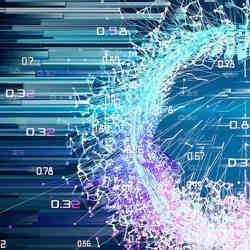
From compasses and thermometers to accelerometers and LiDAR, scientists and inventors have long searched for tools that help us understand our world better. Yet these devices typically run into the same basic limitation: they can only detect signals across a relatively narrow spectrum of light, sound, motion, and gravity waves.
That's poised to change. An emerging field called quantum sensing allows scientists to peer deeper into the surrounding world by detecting quantum state changes at an atomic and sub-atomic level. This technology would allow cars to see through fog, doctors to conduct medical scans with millimeter accuracy, and scientists to identify changes in the Earth that lead to seismic events such as earthquakes and volcanic eruptions.
The technology is nothing less than revolutionary. "Quantum sensors take detection far beyond what has ever been possible," says Kai Bongs, a professor in the School of Physics and Astronomy at the University of Birmingham in the U.K. "The field is likely to disrupt science and the economy in a major way."
Deep Sensing
The technology represents a quantum leap in sensing. Explained Jonathan L. Habif, a research assistant professor of electrical and computer engineering and research lead at the University of Southern California (USC), "For hundreds of years, we've modeled light and other properties as a wave based on their physical characteristics. But we're not able to calculate the fundamental structure and limits of nature simply by measuring light, sound or magnetic performance."
Yet characteristics such as light, sound, vibration, pressure, and magnetism are more than electromagnetic waves: "They're quantum mechanical systems," Habif says. This means some characteristics, qualities, and details lie beyond the scope of classical sensors. Yet by measuring movements, rotations, absorption, and numerous other physical properties, quantum sensors can peer into these previously invisible places.
Some quantum methods involve manipulating or "squeezing" photons to produce a higher signal-to-noise ratio, which enables ultrasensitive measurements. Others enhance or alter light-matter interactions. In the latter case, "This uniquely identifies the 'useful' signal from a classical background noise," says Daniele Faccio, Royal Academy of Engineering Chair in Emerging Technologies at the University of Glasgow School of Physics & Astronomy.
"Everything you can do classically, you can do quantum-mechanically," says Federico Spedalieri, a research assistant professor at USC, "but quantum mechanics may allow you to perform some sensing tasks better." In addition, he says quantum mechanics "introduces certain measurements that have no equivalent in classical systems." For example, it would allow a LiDAR system to see through fog, and perhaps around corners. It also makes it possible to develop sensing systems that find buried objects.
Seeing the Light
The scale of improvement that quantum systems can deliver is remarkable. For instance, current LiDAR systems bounce a laser beam off an object and measure the time it takes to return to the sensor; it typically takes somewhere in the range of 100 milliseconds. However, a quantum sensor can reduce sensitivity to the travel time for a photon to the trillionths of a second, while detecting things that typical LIDAR cannot see.
What's more, Faccio says future quantum LIDAR systems could use correlated or entangled techniques, with "one photon used to illuminate the scene and the other photon used to isolate the return signal from the background to certify the origin of the return photon." This would create a secure system that could not be hacked.
Quantum sensing will likely usher in an incredible array of other advancements, including enabling systems that scan the human brain for dementia, deliver far more precise navigation capabilities, and detect underground oil and mineral deposits, as well as the likelihood a volcano will erupt using quantum gravimeters. Bongs is currently testing quantum sensing to find unmapped abandoned mineshafts in the U.K.
Another area of intense interest is astronomy. Traditionally, determining light sources in distant galaxies presents enormous challenges, Spedalieri says. "It's very difficult to determine whether light is coming from one star or two stars. "The classical way to do this is to measure the light through an optical system—in this case, the lenses—and form an image on an optical plane. It could be very difficult to distinguish between two closely spaced sources and a single source, but with quantum sensing you can make that decision by measuring fewer photons and yet clearly see what is taking place."
So far, a handful of firms have introduced quantum sensing devices. The biggest hurdle is taking the technology from the lab to real-world environments, Faccio says. Researchers are developing more advanced lasers, vacuum chambers, and other critical elements. "Quantum sensing will likely take hold with high-value applications and eventually move into the mainstream," Habif says.
Concludes Bongs, "There are numerous ideas for how to use quantum sensing. The technology will allow us to understand and act on the world in profoundly different ways."
Samuel Greengard is an author and journalist based in West Linn, OR, USA.



Join the Discussion (0)
Become a Member or Sign In to Post a Comment